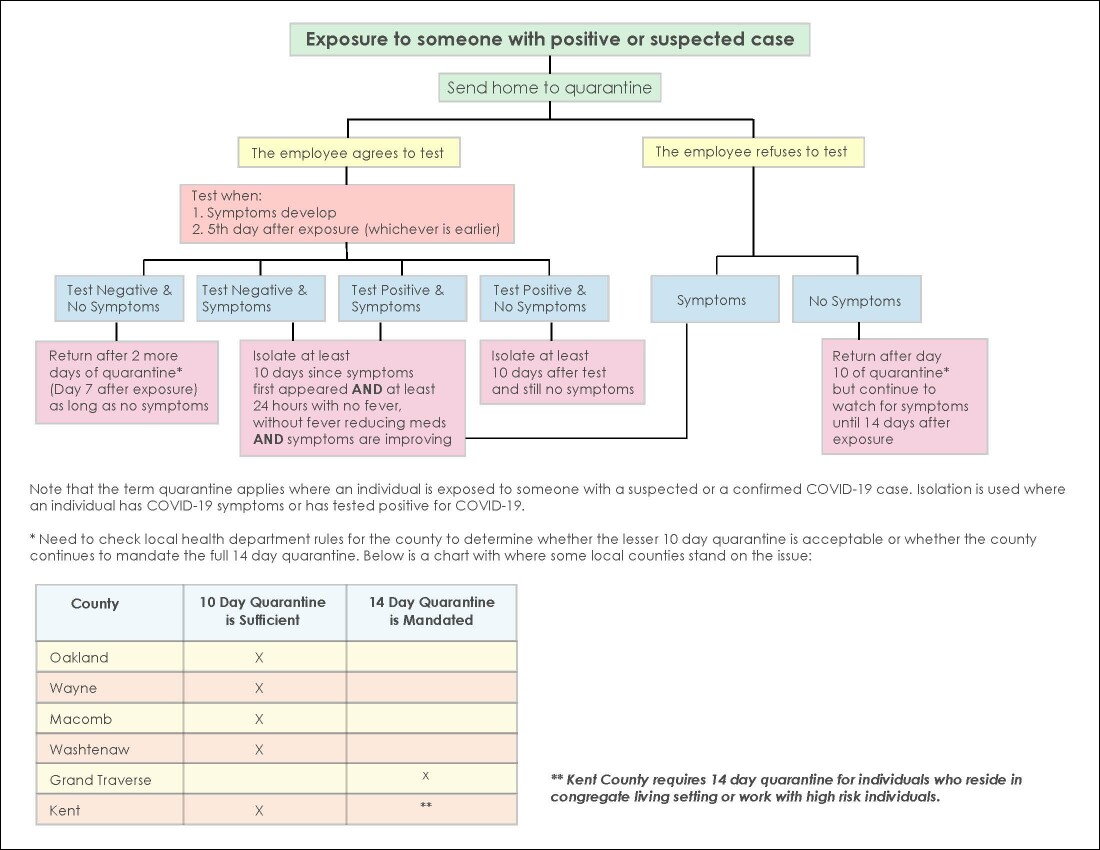When and for how long must an employee quarantine after exposure to COVID-19?
As COVID-19 cases in Michigan are on the rise, employers face questions about when employees need to quarantine or isolate and for how long. Such a determination involves the daunting task of navigating the intersection of MIOSHA’s COVID-19 Emergency Rules, Michigan’s COVID-19 Employment Rights Act, the CDC’s Guidelines, and orders from local health departments.
MIOSHA’s Emergency Rules prohibit employers from allowing employees with known or suspected cases of COVID-19 to be in the workplace while they are infectious. To mitigate the risk posed by the presence of infectious employees, MIOSHA requires employers apply a number of precautions with which they are now very familiar, including conducting a daily self-screening for all employees onsite. Should the self-screen questionnaire reveal that an employee has been exposed to a person with COVID-19 outside the workplace, MIOSHA requires that employers follow the latest guidelines from the CDC and any quarantine or isolation order by the local public health department. Employers must do the same for employee exposure that occurred in the workplace.
Michigan’s COVID-19 Employment Rights Act protects employees against discrimination and retaliation for following the Act’s proscribed quarantine or isolation requirements. It also provides an affirmative defense to employers against liability if they comply with the quarantine and isolation requirements.
Whether an employee has been exposed to COVID-19 so as to require quarantine under either MIOSHA’s Emergency Rules or the COVID-19 Employment Rights Act, turns on whether the employee had close contact with a person with COVID-19. However, MIOSHA’s Emergency Rules define “close contact” differently than the COVID-19 Employment Act (as the Act relies on the CDC’s definition, which is different).
MIOSHA defines “close contact” as spending at least 15 minutes within six feet of a person with COVID-19, even if that contact occurred 2 days before the person’s symptoms appeared or, if asymptomatic, 2 days before the specimen was collected that yielded the positive test. The CDC’s current definition includes MIOSHA’s definition with slight modifications. First, it specifies that the minimum 15 minutes must be cumulative over a period of 24 hour period (e.g., three individual 5-minute exposures for a total of 15 minutes in one day). Second, it notes that it is still close contact even if those involved wore masks. Third, it includes the following situations:
- providing home care to someone with COVID-19;
- direct physical contact with someone with COVID-19 (e.g., hugged or kissed them);
- sharing eating or drinking utensils with someone with COVID-19; and
- direct exposure to respiratory droplets from someone with COVID-19 (e.g., person with COVID-19 sneezed or coughed on you).
To ensure compliance, employers should use the CDC’s more expansive and specific version. However, should the CDC’s definition change to be less restrictive than MIOSHA’s definition (e.g., by reducing the distance from 6 feet to 3 feet), employers should continue to use MIOSHA’s definition.
Because MIOSHA’s Emergency Rules and the COVID-19 Employment Act both defer to the CDC and local health departments to determine the length of a quarantine after exposure, employers must say up to date with the CDC’s changing recommendations. But the CDC Guidelines do not control if the local health department has adopted a different quarantine period. For example, although the CDC recommends the full 14-day quarantine, it has endorsed a reduction to 10 days without symptoms or 7 days with a negative test and no symptoms. For example, while Oakland County Health Division expressly allows the 10 day reduction, Grand Traverse County specifically requires the full 14 day quarantine and states that employees “cannot test out of quarantine.” An employer in Grand Traverse County, therefore, must require the longer 14 day quarantine.
The following flow chart will help assist employers and human resources professionals determine how long to quarantine an employee who has been exposed to someone with a positive or suspected COVID-19 case. It also provides the current quarantine periods for various counties. This chart assumes that the employee in question has not been fully vaccinated or had COVID-19 in the last 3 months. Following the CDC’s most recent guidelines, if an employee has either had COVID-19 in the last 3 months or been fully vaccinated and does not display COVID-19 symptoms, he or she does not need to quarantine but should still monitor for COVID-19 symptoms for 14 days following an exposure. An employee is considered fully vaccinated at least two-weeks after they have received the second does in a 2-dose series (Pfizer-BioNTech or Moderna) or two-weeks after they have received a single-dose vaccination (Johnson&Johnson). Again, employers must check with their local county health departments to confirm quarantine exemptions for employees who had COVID-19 or are fully vaccinated.
When reviewing MIOSHA’s Order, the COVID-19 Employee Act, the CDC’s Guidelines, and the flow chart, it is important to note the distinction between “quarantine” and “isolation,” which we tend to use interchangeably in common parlance. While both terms involve separating an individual from the healthy population, they refer to separation for different groups. The term “quarantine” relates to separating people who have been exposed to COVID-19 to see if they become sick, whereas “isolation” relates to separating people who tested positive for COVID-19 or display COVID-19 symptoms.

Click here for a PDF version of the flowchart.
Please do not hesitate to contact your Butzel attorney with questions about when and for how long an employee needs to quarantine or isolate.
Sarah Nirenberg
248.258.2912
nirenberg@butzel.com
Brett Miller
313.225.5316
millerbr@butzel.com










